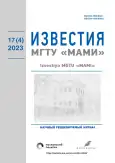Разработка и исследование модели псевдошагающего робота
- Авторы: Дьяков А.С.1, Евсеев К.Б.1, Федоров Д.С.1
-
Учреждения:
- Московский государственный технический университет им. Н.Э. Баумана (национальный исследовательский университет)
- Выпуск: Том 17, № 4 (2023)
- Страницы: 435-446
- Раздел: Электротехнические комплексы и системы
- URL: https://journal-vniispk.ru/2074-0530/article/view/252149
- DOI: https://doi.org/10.17816/2074-0530-623720
- ID: 252149
Цитировать
Полный текст
Аннотация
Обоснование. Создание роботов, которые могут двигаться как в шагающем, так и в колёсном режиме, и в то же время отличаются от уже созданных роботов простой конструкцией, является актуальной задачей последних лет. Если такой робот будет сопоставим по конструктивной сложности, плавности хода, надёжности и себестоимости с колёсным аналогом, и, кроме того, будет способен устойчиво и быстро передвигаться по непроходимому для колёсных роботов рельефу, то это может гарантировать научный и коммерческий успех такого изделия. Динамика движения робота описывается средствами программных комплексов «Универсальный механизм» и «Matlab Simulink». В статье приведены результаты виртуальных испытаний робота в основных режимах движения (прямолинейный курс, поворот, преодоление ступени).
Цель работы — повышение подвижности робота, оборудованного псевдошагающей ходовой системой путём использования рациональных законов управления.
Методы. Для оценки ходовых качеств исследуемого робота используются методы имитационного математического моделирования его движения с использованием программных комплексов исследования динамики систем твёрдых тел.
Результаты. Для заданной мощности двигателей были получены: максимальная скорость устойчивого прямолинейного движения, скорость поворота, высота наибольшей преодолеваемой ступени.
Заключение. Разработана новая модель мобильного робота, оборудованного ходовой системой простой конструкции. Данная модель по результатам испытаний продемонстрировала высокие показатели проходимости и другие показатели подвижности.
Полный текст
Открыть статью на сайте журналаОб авторах
Алексей Сергеевич Дьяков
Московский государственный технический университет им. Н.Э. Баумана (национальный исследовательский университет)
Email: diakov57@list.ru
ORCID iD: 0009-0005-7787-2354
SPIN-код: 9437-8400
д-р техн. наук, профессор кафедры «Колёсные машины»
Россия, МоскваКирилл Борисович Евсеев
Московский государственный технический университет им. Н.Э. Баумана (национальный исследовательский университет)
Email: kb_evseev@bmstu.ru
ORCID iD: 0000-0001-7193-487X
SPIN-код: 7753-2047
д-р техн. наук, профессор кафедры «Колёсные машины»
Россия, МоскваДмитрий Сергеевич Федоров
Московский государственный технический университет им. Н.Э. Баумана (национальный исследовательский университет)
Автор, ответственный за переписку.
Email: fds16m576@student.bmstu.ru
ORCID iD: 0009-0006-6141-7864
студент кафедры «Многоцелевые гусеничные машины и мобильные роботы»
Россия, МоскваСписок литературы
- Игнатьев М.Б., Владимиров С.В., Сапожников В.И., и др. Шагающие роботы — проблемы и перспективы // Инноватика и экспертиза: Научные труды. 2016. № 2 (17). С. 128–137.
- Котиев Г.О., Дьяков А. С. Методы разработки ходовых систем высокоподвижных безэкипажных наземных транспортных средств // Известия Южного федерального университета. Технические науки. 2016. № 1 (174). С. 186–197.
- Дьяков А.С. Научные методы разработки ходовых систем высокоподвижных безэкипажных наземных транспортных средств // Труды НГТУ им. Р.Е. Алексеева. 2019. № 1 (124). С. 146–159.
- Velimirovic A., Velimiroviс M., Hugel V., et al. A new architecture of robot with “wheels-with-legs” (WWL) // Advanced Motion Control. 1998. P. 434–439.
- Chen W.-H., Lin H.-S., Lin Y.-M., et al. Turboquad: A novel leg-wheel transformable robot with smooth and fast behavioral transitions // IEEE Transactions on Robotics. 2017. Vol. 33, N. 5. P. 1025–1040. doi: 10.1109/TRO.2017.2696022
- Saranli U., Buehler M., Koditschek D.E. RHex: a simple and highly mobile hexapod robot // International Journal of Robotics Research. 2001. Vol. 20, N. 7. P. 616–631. doi: 10.1177/02783640122067570
- Silva M., Tenreiro Machado J.T. A Historical Perspective of Legged Robots // Journal of Vibration and Control. 2007. Vol. 13, N. 9–10. P. 1447–1486. doi: 10.1177/1077546307078276
- Универсальный механизм 9. Руководство пользователя [internet] [дата обращения: 25.08.2023] Режим доступа: http://www.umlab.ru/pages/index.php?id=3
- Лапшин В.В. Об устойчивости движения шагающих машин // Наука и образование: научное издание МГТУ им. Н.Э. Баумана. 2014. № 06. С. 319–335.
Дополнительные файлы



















